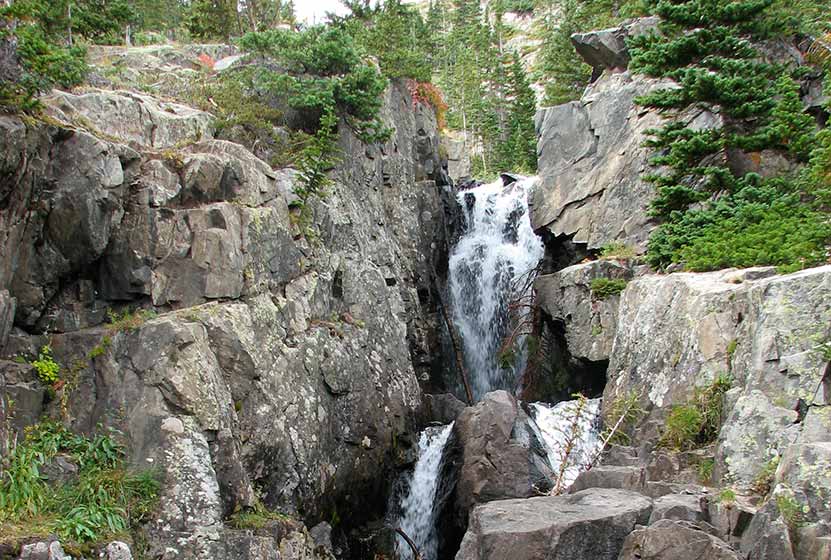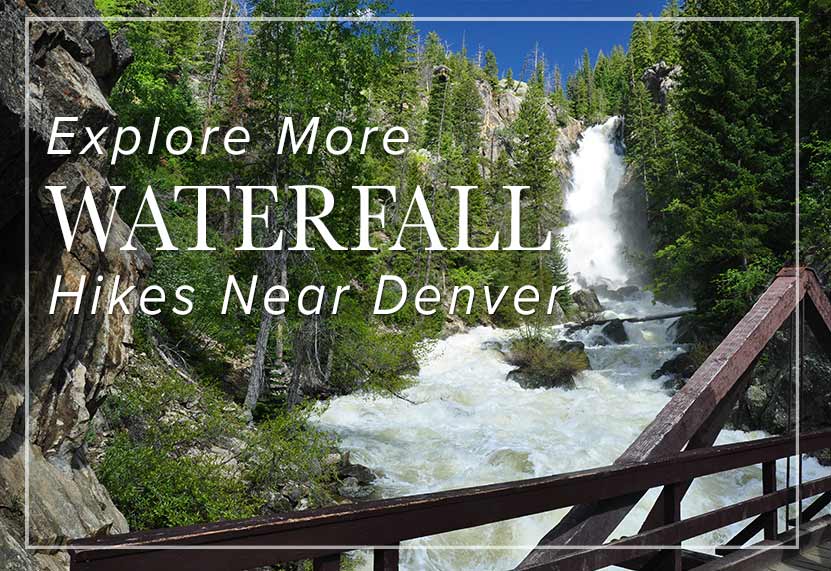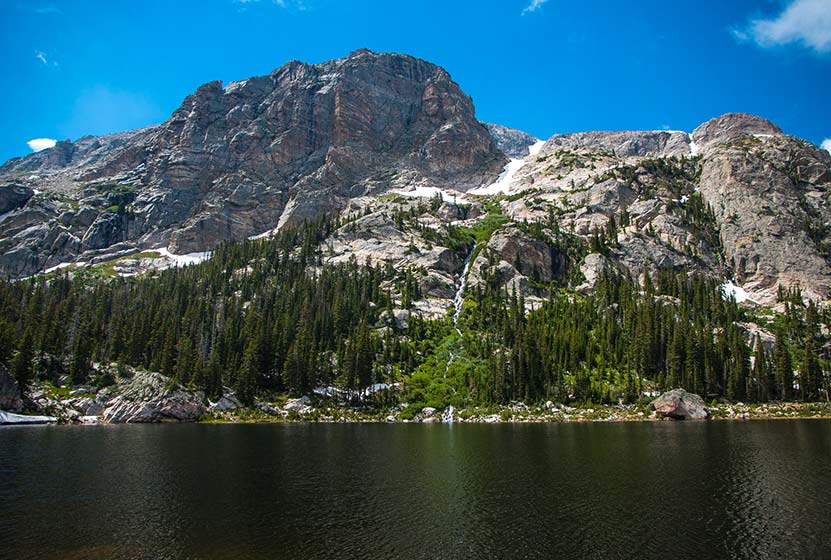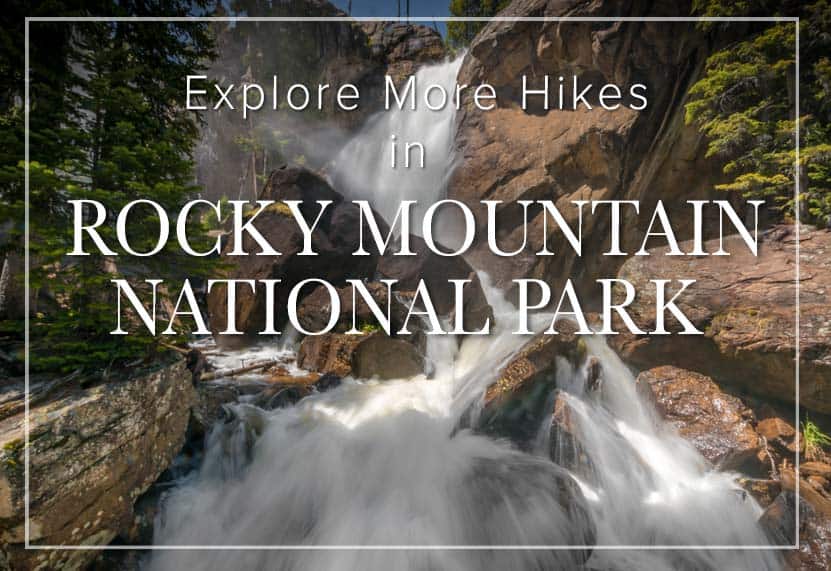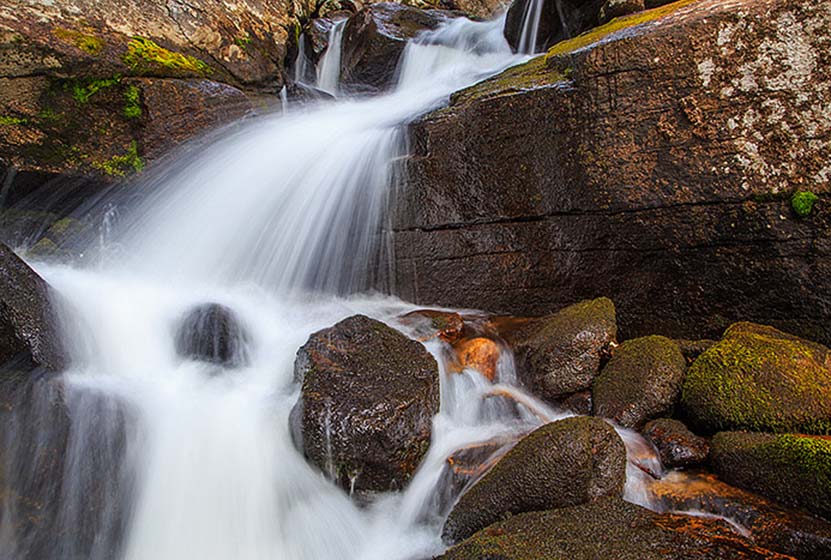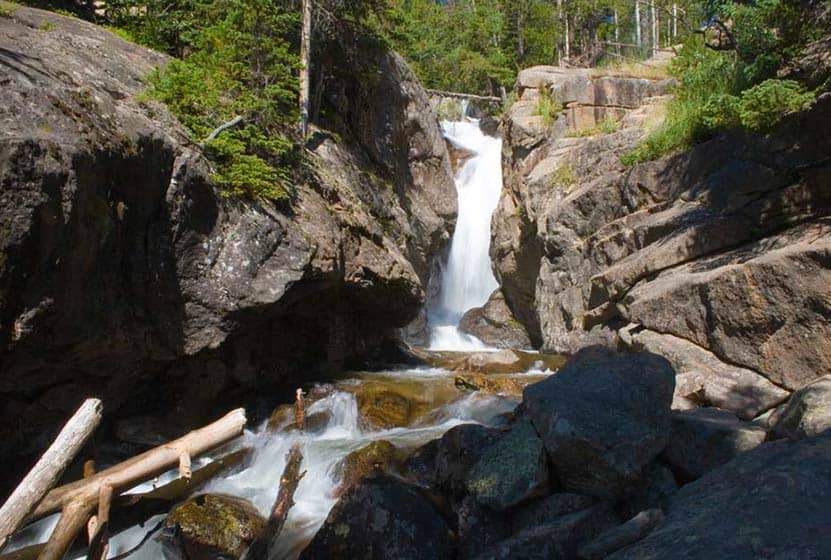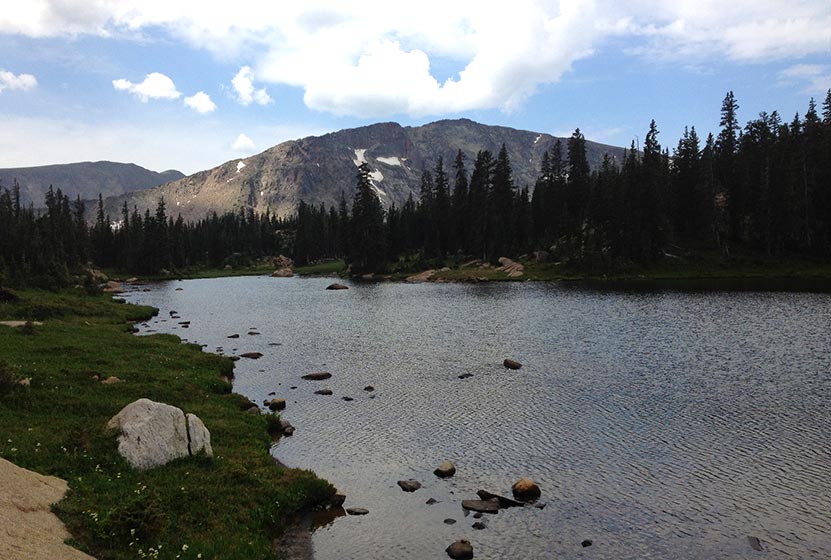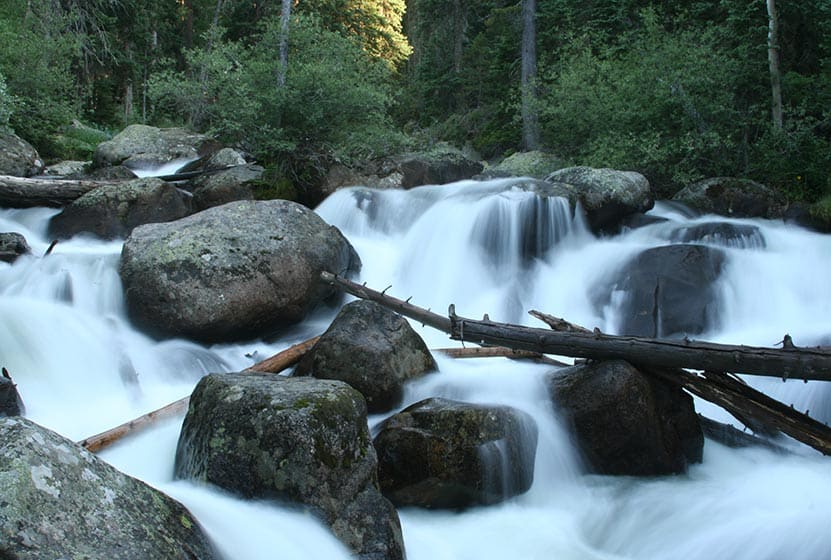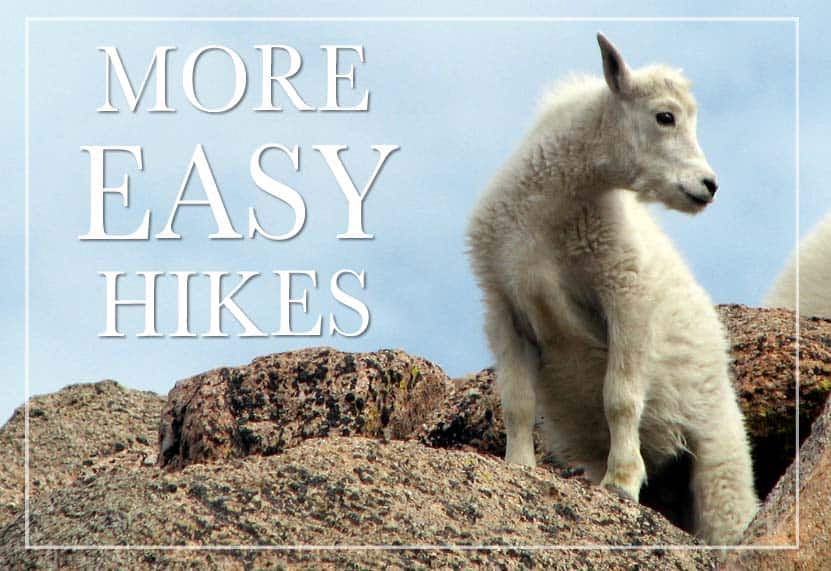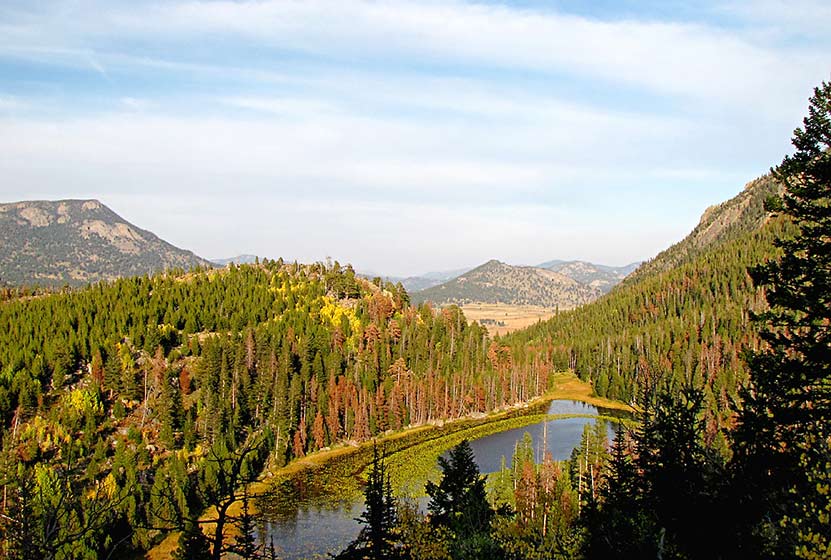Continental Falls Hike Near Breckenridge
Continental Falls crashes through cracks in the granite sides of the mountains near Breckenridge Colorado. It's a moderate 2.5 mile uphill hike to the base of the waterfall. The 1000+ feet of elevation gain require some bodily exertion, but it's worth the effort. Located on the eastern slopes of the Mosquito Range, waterfall finds its source in the high mountain Mohawk Lakes as they spill out into Spruce Creek and make their way down the mountainside. The trail boasts spectacular mountain views, lakes, and the ruins of an old mining operation. Explore the full Continental Falls hike profile below for trail map, driving directions, and more tips and details to help you enjoy this hike near Breckenridge.
Trail Snapshot: Continental Falls Trail near Breckenridge, Colorado
| Hike Distance | Approx 5 miles Round Trip |
|---|---|
| Difficulty | Moderate |
| Duration | Approx 4 hrs |
| Trail Type | Out and Back |
| Starting Elevation | 10380′ |
| Elevation Gain | +1070′ |
| Seasons | Year Round |
| Dogs | Allowed On Leash |
| Hike Trail Map for Continental Falls | Click for a Map |
| Denver Drive Time | 1 hr 40 min |
| Driving Directions to Spruce Creek Trailhead | Click for Google Map |
| Town Nearest Hike | Breckenridge, Colorado |
| Beauty | waterfall, lakes, cabin ruins, creek, mountain views |
| Activities | Hiking, photography, horseback riding, fishing |
Parking & Trailhead Information for Continental Falls Hike
From Breckenridge, follow CO 9 South to The Spruce Creek Road. This is found on the right/west approximately 2.5 miles from the south end of town (junction of Main and South Park Ave). The trailhead for this hike to Continental Falls is located approximately 1.1 mile up Spruce Creek Road.
The Hike: Continental Falls Trail
The hike up to Continental Falls follows the Spruce Creek Trail. It's marked with blue diamond blazes making the trail easy to find and follow. Just shy of a 1/2 mile into the hike, the trail will cross Spruce Creek via a footbridge. At this point, the forest opens up a bit to views of my Helen in the distant west.
About 1.7 miles into the hike, the Spruce Creek trail will intersect with the Wheeler Trail. At this junction, continue straight on Spruce Creek Trail. At approximately 2 miles, the Spruce Creek trail will join up with the 4WD road, for a short jaunt past a small dam, then will connect back in with the Spruce Creek trail.

At about 2.5 miles into the hike, the trails reaches another junction. The left-hand trail leads up to Continental Falls and beyond to Mohawk Lakes. This segment of the trail is one of my favorites, as it leads past the ruins of a mining operation complete with cabins, mine shaft, and old mining equipment. Be sure to exercise caution and read the warning signs around such areas. At approximately 2.6 miles into the hike, the trail will arrive at Continental Falls. After taking in the waterfall, hikers often opt to go further up to gain incredible mountain peak and mountain range views at Mohawk Lakes.
Tips & Resources for Hiking the Continental Falls Trail
- TIP: There is a mine ruins off trail nearby. Be careful as there is a warning sign that it could collapse and may produce dangerous gases.
- Trail Map for Continental Falls: Trail Map
- Packing List: Always pack the 10 Essentials. Download our Hiking Guide to get the list and dayhiking packing checklist.
- Colorado Road Conditions: Colorado Road Conditions
- After the Hike: The Crown
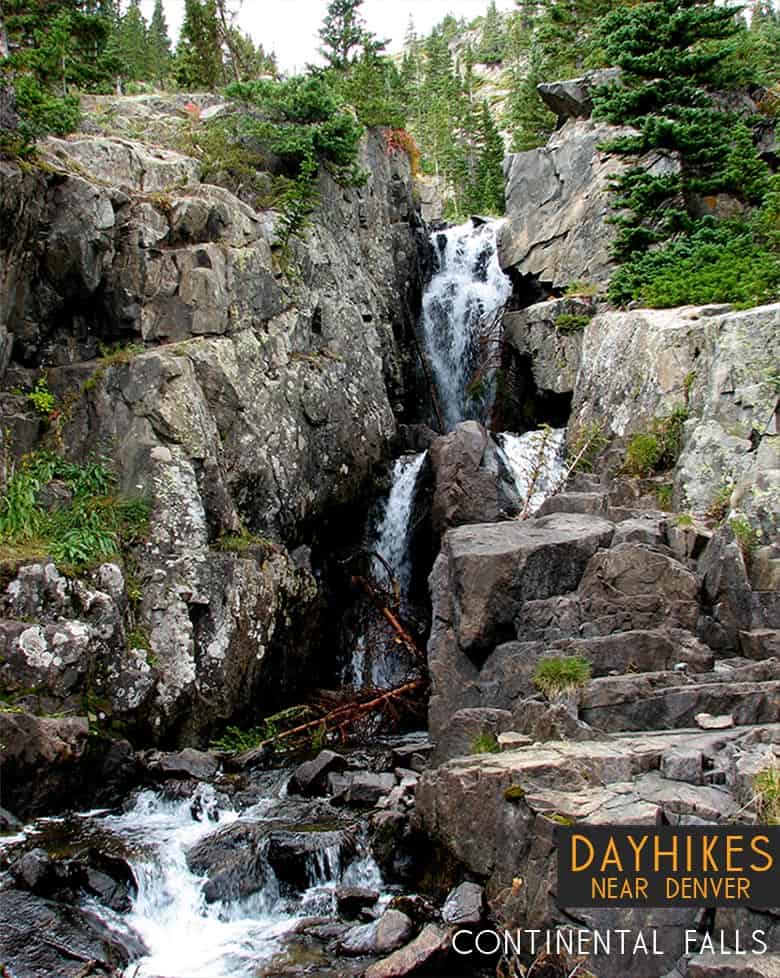
Weather
Map & Driving Directions
Click for Driving Directions
Looking for more waterfalls near Denver? Explore our more than 50 Colorado Waterfall Hikes, our favorite Waterfall Hikes in Rocky Mountain National Park, or 7 Waterfalls within One Hour of Denver.
Pear Lake Hike in Rocky Mountain National Park
Pear Lake is a great destination for solitude, fishing, and mountain views. It's a 6.5 mile, demanding hike through some of the best wildflower country in Rocky Mountain National Park. After passing Finch Lake, the trail makes its way to the higher, Pear Lake where Copeland Mountain appears to shoot straight from its shores into the sky. Explore the full Pear Lake hike profile below for trail map, driving directions, and more tips and details to help you enjoy this adventure in Rocky Mountain National Park.
Note: Rocky Mountain National Park now requires timed entry permits from May 27th through October 10th. See the RMNP permits page for more information.
Trail Snapshot: Pear Lake in Rocky Mountain National Park
| Hike Distance | 13 miles Round Trip |
|---|---|
| Difficulty | Difficult |
| Duration | Approx 7-8 hr Round Trip |
| Trail Type | Out and Back |
| Starting Elevation | 8470′ |
| Elevation Gain | Approx +2112′ |
| Seasons | Spring through Fall, Winter Snowshoeing |
| Dogs | Prohibited in RMNP |
| Hike Trail Map | Click for a Map of Pear Lake RMNP |
| Denver Drive Time | 1 hr 30 min |
| Driving Directions to Finch Lake Trailhead | Click for Google Map |
| Town Nearest Hike | Allenspark, Colorado |
| Beauty | Waterfall, mountain views, meadows, aspen, river, wildlife: blue dragonfly, jackrabbit, mallard, Abert’s squirrel, elk, deer, moose, bear; wildflowers |
| Activities | Picnicking, hiking trails, fishing, snowshoeing, horseback riding, backcountry camping (with a permit), photography |
| Fee | Park Pass Required |
Parking & Trailhead Information for Pear Lake
The hike to Pear Lake begins at the the Finch Lake Trailhead, located approximately 1/5th of a mile east of the larger Wild Basin Trailhead near Allenspark, Colorado. Because there is very limited parking at the Finch Lake Trailhead, most hikers will need to park at the Wild Basin Trailhead and add the 1000' feet of trail between the Wild Basin Trailhead and the Finch Lake Trailhead to their journey. There is an alternative approach via the Allenspark Trailhead. However, the route described in this trail profile will be from the Finch Lake Trailhead nearest to the Wild Basin Trailhead.
- Map and Driving Directions to the Finch Lake Trailhead
- Map and Driving Directions to the Wild Basin Trailhead
The Hike: Pear Lake Trail in RMNP
The hike up to Pear Lake is a steady climb through a forest of pine, aspen, spruce, and meadows laden with wildflowers. It's a demanding hike from the outset, coursing up a set of switchbacks to gain the ridge of a lateral moraine. After this initial east bearing segment, the trail turns back to the west begins a gentle descent through one of Rocky Mountain National Park's most stunning displays of wildflowers. Near the bottom of the moraine, near Fox Creek, the trail encounters its first junction. The the trail to the right/west leads towards both Finch and Pear lakes (the left/east trail leads to the Allenspark Trailhead). Climbing higher, the trail will pass an overlook with views of the distant mountain peaks of Pagoda, Meeker, and Chief's Head, as well as views of the greater Wild Basin area.
The next trail junction--at approx. 2.5 miles--has been named "Confusion Junction" because of its power to confound hikers. Pause and study the trail signage in order to choose the correct trail. The correct way is the trail labeled "Pear Lake" and/or "Finch Lake."
After approximately 1/4 mile, the trail passes through a burn area from the 1978 fire, which has made a good recovery and is now riddled with summer wildflowers. Continuing to work uphill, the trail makes several stream crossings before a descent to Finch lake, which begins at 3.8 miles. Then, at approximately 4.25 miles, the trail makes a hard right-turn. This part of the trail is often obscured by snow as late as as midsummer and early as the first signs of autumn.
At Finch Lake the trail wraps around the eastern edge, then the northern shore of the lake. The next segment of trail, from Finch Lake to Pear Lake is approximately 2 miles. These are steep and demanding. Winter snows last into the early months of summer. July brings an incredible display of wildflowers in both the forest and meadows, and the abundance of moisture and vegetation makes this broad valley a great place for viewing wildlife.

At approximately 6 miles, the trail will cross pear creek. The forest then gives way to rock and eventually to Pear Lake. Pear Lake is enclosed by a ring of rock and mountain. The rugged rock and cliffs of Copeland Mountain come down to meet the northwestern shores. In the early hours of morning, the images Copeland Mountain and Ouzel peak can be seen mirrored in the lake.
Pear Lake is a great place to fish and is catch and release only. A fishing license is required and State and Park fishing regulations apply. There are two campsites near Pear Lake: Pear Creek (just below the lake), and Pear Lake Campsite. These backcountry camping sites can be reserved through the RMNP Backcountry Offices. Because this is such an extensive hike (13 miles roundtrip), camping may be a good option if you want to fish or explore the surrounding area.
Further exploration can be made of the Cony Creek drainage where a series of paternoster lakes lead up to the highest lake, Cony Lake. This area does not have maintained trails and requires hikers to have well-developed backcountry land navigation skills.
Tips & Resources for Hiking to Pear Lake in RMNP
- Packing List: Always pack the 10 Essentials. Download our Hiking Guide to get list and dayhiking packing checklist.
- Fuel Your Body: It's a long and very demanding hike, so be sure to bring plenty of water and food for the trip.
- Get there early: Parking lot might get full even early in the morning.
- You’re in Bear Country: Black Bears live in the Wild Basin area and are active on the months of April through November. Be aware, dispose of your food responsibly, and don’t food or anything else with a strong scent in your vehicle.
- Trekking Poles: For most hikes in RMNP, especially if you are traveling on unmaintained trails, we recommend using Trekking Poles. They take a lot of weight off the knees and help in navigating uneven terrain.
- Trail Map for Wild Basin Area: Trail Map Link
- Colorado Road Conditions: Colorado Road Conditions
- Photo: We would like to express our gratitude to Shea Oliver for sharing such amazing photographs of this hike to Pear Lake in RMNP.
- After the Hike: Rock Creek Tavern & Pizzeria
Weather
Map & Driving Directions
Click for Driving Directions
Lawn Lake Hike in Rocky Mountain National Park
The hike to Lawn Lake in Rocky Mountain National Park follows the course of the Roaring River for 6.2 miles to a stunning high mountain lake with great fishing. This demanding hike takes adventurers into the heart of the Mummy Range, a lesser visited region of RMNP. Explore the full Lawn Lake hike profile below for trail map, driving directions, and more tips and details to help you enjoy this adventure in Rocky Mountain National Park.
Note: Rocky Mountain National Park now requires timed entry permits from May 27th through October 10th. See the RMNP permits page for more information.
Trail Snapshot: Lawn Lake in Rocky Mountain National Park
| Hike Distance | 12.4 miles Round Trip |
|---|---|
| Difficulty | Difficult |
| Duration | Approx 7-8 hr Round Trip |
| Trail Type | Out and Back |
| Starting Elevation | 8540' |
| Elevation Gain | Approx. +2249' |
| Seasons | Spring through Fall |
| Dogs | Prohibited in RMNP |
| Hike Trail Map | Click for a Map of Lawn Lake RMNP |
| Recommended Trail Map | We recommend the National Geographic Trails Illustrated Map - topographic with detailed information. |
| Denver Drive Time | 1 hr 40 min |
| Driving Directions to Lawn Lake Trailhead | Click for Google Map |
| Town Nearest Hike | Estes Park, Colorado |
| Beauty | Lake, waterfall, mountain views, aspen, ponderosa, meadows, river, wildlife: elk, Abert's squirrel; wildflowers |
| Activities | Picnicking, hiking trails, fishing, snowshoeing, horseback riding, backcountry camping (with a permit), photography |
| Fee | Park Pass Required |
Parking & Trailhead Information for Lawn Lake
The hike to Lawn Lake begins at the Lawn Lake Trailhead. Several other destinations in this lesser visited section of RMNP known as the Mummy Range, can be accessed from the Lawn Lake Trailhead, including Ypsilon Lake, Ypsilon Falls, Chipmunk Lake, and the Spectacle Lakes. The parking area is located on Old Fall River Road, just north of the intersection of Old Fall River Road and Highway 34.
The Hike: Lawn Lake Trail in RMNP
The hike begins on a 1.4 mile stretch of the Lawn Lake trail before the intersection with the Ypsilon Lake Trail. This initial segment climbs a series of switchbacks. While it may be tempting to cut the switchbacks, they are there for a couple important purposes: to control erosion and to preserve your energy. Because this area of the park has been severely damaged by floods, it’s all the more important to stay the trail.
At approximately 1.4 miles, the Lawn Lake Trail meets with the Ypsilon Lake Trail. See the full trail profiles for Ypsilon Lake and Ypsilon Falls for exploring these destinations. At the junction, the way to the Lake passes by this junction, continuing straight/North on the Lawn Lake Trail
Here, the trail comes quite close to the gorge that overlooks Roariing River. There are areas of unstable terrain and hikers should take caution and stay away from the precarious edges of the gorge.
The trail begins a demanding climb up a series of switchbacks then returns to follow river. Three backcountry camping sites are located in this stretch, just after the confluence of Roaring River and Ypsilon Creek: Ypsilon Creek, Cutbank, and Golden Banner. At 5.6 miles, the Lawn Lake Trail meets up with the Black Canyon Trail. Here, the way to the Lake is left/North, and should be clearly marked by a sign at the junction. The Lake is about 1/2 a mile further up the trail.
There is another backcountry camping site at the Lake. This site and the others along the Lawn Lake trail can be reserved through the RMNP Backcountry Offices. Greenback Cutthroat trout are plenty in the Lake, so this makes for a great fly fishing destination in Rocky Mountain National Park. A fishing license is required and State and Park fishing regulations apply.
Tips & Resources for Hiking to Lawn Lake in RMNP
- Explore More: Crystal Lake is just about 1.5 mi further. You may opt to continue if you have energy to spare.
- Packing List: Always pack the 10 Essentials. Download our Hiking Guide to get list and dayhiking packing checklist.
- Get there early: Parking may be somewhat limited as with many hikes in RMNP area and can get full even early in the morning.
- Recommended Trail Map: We recommend the National Geographic Trails Illustrated Map which indicates the location of the Upper Chipmunk Backcountry Camping Site, and provides topo information.
- Colorado Road Conditions: Colorado Road Conditions
- Photo: We would like to express our gratitude to Chad Bowman for sharing such an amazing photograph of this hike to Lawn Lake in RMNP.
- After the Hike: Mountain Home Café
Weather
Map & Driving Directions
Click for Driving Directions
Lyric Falls Hike in Rocky Mountain National Park
Lyric Falls is a beautiful stair-step waterfall that spills over the moss-covered granite slabs of Hunters Creek in Rocky Mountain National Park. A lesser-known waterfall, Lyric Falls requires a 3/4 mile segment on the unmaintained social trail that winds along Hunters Creek. Locating the falls may be a bit challenging and land navigation skills are needed for this hike in the Wild Basin area of RMNP. Explore the full Lyric Falls hike profile below for trail map, driving directions, and more tips and details to help you enjoy this adventure in Rocky Mountain National Park.
Note: Rocky Mountain National Park now requires timed entry permits from May 27th through October 10th. See the RMNP permits page for more information.
| Hike Distance | Approx 8 miles Round Trip |
|---|---|
| Difficulty | Moderate |
| Duration | 6-8 hr Round Trip |
| Trail Type | Out and Back |
| Starting Elevation | 8430' |
| Elevation Gain | Approx. +1730' |
| Seasons | Spring through Fall |
| Dogs | Prohibited in RMNP |
| Hike Trail Map | Click for a Map of Wild Basin Area |
| Trails Illustrated Map | Recommended Topo Map Noting Location of Lyric Falls |
| Denver Drive Time | 1 hr 30 min |
| Driving Directions to Sandbeach Lake Trailhead | Click for Google Map |
| Town Nearest Hike | Allenspark, Colorado |
| Beauty | Mountain views, aspen, ponderosa, limber pine, creek, wildlife: Abert’s squirrel, elk, deer, moose, bear; wildflowers |
| Activities | Picnicking, hiking trails, winter snowshoeing, horseback riding, backcountry camping (with a permit), photography |
| Fee | Park Pass Required |
Parking & Trailhead Information for Lyric Falls
The Sandbeach Lake Trailhead is located off of County Road 84 near, just about 1/2 mile west from its junction with Highway 7. See the driving directions link above for the detailed route. The trailhead is across the street from the Wild Basin Lodge and Event Center. The trailhead has toilet facilities and parking capacity of about 25 cars (includes gravel side-lot).
The Hike: Lyric Falls Trail in RMNP
The first segment of the hike to Lyric Falls follows the Sandbeach Lake Trail for approximately 3.2 miles to the footbridge crossing Hunter's Creek. An indistinct social trail is located near the bridge on the east side of Hunter's creek. This second trail segment is 3/4 of a mile is unmaintained, which means that hikers should have a sufficient level of land navigation skills (map reading and proficiency with a compass/gps unit) to negotiate the terrain to Lyric Falls.
This .75 mile section follows the course of Hunter's Creek Northwest and uphill to the location of Lyric Falls. There is no marker for Lyric Falls, but it can be located on the National Geographic Trails Illustrated Map of Rocky Mountain National Park. Hikers will likely hear several smaller cascades along the way. In the same way, the cascades of Lyric Falls will be heard before seen, and the sounds of its splash and spray will be the best way to locate the falls.
A meadow bright with wildflowers can be found just bit further up Hunter's Creek beyond Lyric Falls.
Campsites Along the Lyric Falls Trail
Stay overnight and explore the larger Hunter's Creek Drainage. There are several Backcountry Camping sites along the Sandbeach Lake Trail: Hole-in-the-Wall, Campers Creek, Beaver Mill, and Sandbeach Lake. These backcountry camping sites can be reserved through the RMNP Backcountry Offices. Staying overnight, hikers can then explore Lyric Falls, Sandbeach Lake, and this lesser hiked area of the Wild Basin in Rocky Mountain National Park.
Tips & Resources for Hiking to Lyric Falls in RMNP
- Packing List: Always pack the 10 Essentials. Download our Hiking Guide to get list and dayhiking packing checklist.
- Recommended Trail Map: We recommend the National Geographic Trails Illustrated Map which indicates the location of the Backcountry Camping Sites, and provides topo information, too.
- Get there early: Parking is limited. Arrive early to secure a parking spot at the trailhead.
- You’re in Bear Country: Black Bears live in the Wild Basin area and are active on the months of April through November. Be aware, dispose of your food responsibly, and don’t food or anything else with a strong scent in your vehicle.
- Colorado Road Conditions: Colorado Road Conditions
- Photo: We would like to express our gratitude to Thomas Mangan for sharing such great photos of this hike to Lyric Falls in RMNP. Tom leads photography tours in Rocky Mountain National Park. Check out his site thomasmagan.com for details.
- After the Hike: Meadow Mountain Cafe in Allenspark, Colorado
Weather
Map & Driving Directions
Click for Driving Directions
Chasm Falls in Rocky Mountain National Park
Chasm Falls in Rocky Mountain National Park bursts through a chasm in Fall River where the rock funnels its waters into a narrow gorge. It's one of the more accessible waterfalls in RMNP, located about 100 yards off of Old Fall River Road. The only drawback is that parking fills fast. However, there are several parking and hike options that we detail in this trail profile. Explore the full Chasm Falls hike profile below for trail map, driving directions, and more tips and details to help you enjoy this adventure in Rocky Mountain National Park.
Note: Rocky Mountain National Park now requires timed entry permits from May 27th through October 10th. See the RMNP permits page for more information.
Trail Snapshot: Chasm Falls in Rocky Mountain National Park
| Hike Distance | 0.1 mile, 2.8, or 4.8 miles (depending on parking area) |
|---|---|
| Difficulty | Easy |
| Duration | 20 minutes to approx 2.5 hrs Round-Trip |
| Trail Type | Out and Back |
| Starting Elevation | 9065' at the pulloff |
| Elevation Gain | Negligible (but more, if hiking up Old Fall River Road) |
| Seasons | Spring through Fall, Winter Snowshoeing |
| Dogs | Prohibited in RMNP but Allowed on certain days on Leash along Old Fall River Road (see details below) |
| Hike Trail Map | Click for a Map of Chasm Falls RMNP |
| Denver Drive Time | 1 hr 40 min |
| Driving Directions to a roadside pulloff area at Chasm Falls Trailhead | Click for Google Map |
| Driving Directions to EndoValley Parking Area | Click for Google Map |
| Driving Directions to West Alluvial Fan Parking Area | Click for Google Map |
| Town Nearest Hike | Estes Park, Colorado |
| Beauty | Waterfall, mountain views, meadows, river, wildlife: elk, big horn sheep, Abert's squirrel, deer, moose, bear; wildflowers |
| Activities | Picnicking, hiking trails, snowshoeing, horseback riding, backcountry camping (with a permit), photography |
| Fee | Park Pass Required |
Parking & Trailhead Information for Chasm Falls
Parking is tricky for Chasm Falls. Depending on where you are able to park, the hike will be a 0.1 mile, 2.8 mile, or 4.8 mile round-trip hike. It's also important to know that Old Fall River Road is closed during the winter months from Nov 30th until the end of March. However, the dirt road gets a lot of traffic and needs a lot of maintenance; so, there may be Spring and Summer closures for repairs. For example, Fall River Road will not open to vehicles in 2016 until early July. We recommend that you visit the Rocky Mountain National Park Road Status page to plan your trip to Chasm Falls and your drive up Old Fall River Road. Below, you'll find the three different parking options
Parking Options for Chasm Falls, Rocky Mountain National Park
#1 - Pulloff Near Chasm Falls - 0.1 Mile Jaunt - Driving Directions
#2 - Endovalley Picnic Area Parking - 2.8 Mile Round Trip Hike - Driving Directions
#3 - West Alluvial Fan Parking Area - 4.8 Mile Round Trip Hike - Driving Directions
During the busy summer months, all of these parking areas fill fast. Dogs are typically not allowed in RMNP, but on certain days, they are allowed along Old Fall River Road as long as they are leashed. See the Old Fall River Road status page for days when dogs are allowed. The scenic drive up Old Fall River Road is half the adventure--but not for the faint of heart. It's a steep dirt road with no guardrails and lots of switchbacks. When the road is open, park visitors can drive it all the way up to the Alpine Visitor Center, and take Trail Ridge Road back down into Estes Park, or take Trail Ridge Road over to the west side of the park in Grand Lake, Colorado.
The Hike: Chasm Falls Trail in RMNP
The hike from the pulloff along Old Fall River Road is well-marked with signs. The short trail of approx. 100 yards leads down stone steps and a steep dirt trail. The bottom of the trail opens to a viewing platform. Like the parking areas, the platform can get quite crowded during the busy summer months.
If hiking up Old Fall River Road from either Endovalley or West Alluvial Fall parking areas, be sure to be aware of vehicles as they make their way up and down the road. This this can be a great winter hike or snowshoe trip during the winter. Usually this means starting from the West Alluvial Fan parking area.
Tips & Resources for Hiking to Chasm Falls in RMNP
- Prepare: Bring water and high-energy food.
- Winter Road Closure: The road is closed to cars during winter. You may opt to plan on a longer hike during this season - starting from the West Alluvial parking area.
- Get there early: Parking may be limited at most of the trailheads in RMNP during the summer months. Go early to get a good spot. By early, we mean before 7:30 AM.
- Trail Map of Fall River Area: Trail Map Link
- Packing List: Always pack the 10 Essentials. Download our Hiking Guide to get list and dayhiking packing checklist.
- Colorado Road Conditions: Colorado Road Conditions
- Photo: We would like to express our gratitude to Tim Vo for sharing such an amazing photograph of this hike to Chasm Falls in RMNP.
- After the Hike: Mountain Home Café
Weather
Map & Driving Directions
Click for Driving Directions to Pulloff Near Chasm Falls
Lion Lake in Rocky Mountain National Park
The Lion Lake #1 in Rocky Mountain National Park boasts a dramatic alpine landscape hidden away in the northwestern corner of the Wild Basin. The trail to this high-mountain lake passes several waterfalls and offers access to other lakes and surrounding peaks. Because the Lions lake is more remote, a trip to it may require an overnight stay at one of RMNP's backcountry camping sites. Explore the full Lion Lake #1 hike profile below for trail map, driving directions, and more tips and details to help you enjoy this adventure in Rocky Mountain National Park.
Note: Rocky Mountain National Park now requires timed entry permits from May 27th through October 10th. See the RMNP permits page for more information.
Trail Snapshot: Lion Lake #1 in Rocky Mountain National Park
| Hike Distance | 14 miles Round Trip |
|---|---|
| Difficulty | Difficult |
| Duration | 7-10 hr Round Trip |
| Trail Type | Out and Back |
| Starting Elevation | 8566' |
| Elevation Gain | Approx. +2565' |
| Seasons | Spring through Fall |
| Dogs | Prohibited in RMNP |
| Hike Trail Map | Click for a Map of Lion Lakes RMNP |
| Recommended Trail Map | National Geographic Trails Illustrated Map |
| Denver Drive Time | 1 hr 30 min |
| Driving Directions to Wild Basin Trailhead | Click for Google Map |
| Driving Directions to Winter Recreation Parking for Wild Basin Hikes | Click for Google Map |
| Town Nearest Hike | Allenspark, Colorado |
| Beauty | Lake, waterfall, mountain views, meadows, river, wildlife: Abert's squirrel, elk, deer, moose, bear; wildflowers |
| Activities | Picnicking, hiking trails, snowshoeing, horseback riding, backcountry camping (with a permit), photography |
| Fee | Park Pass Required |
Parking & Trailhead Information for Lion Lake
The southeast corner of Rocky Mountain National Park boasts one of the loveliest portions in the park known as the Wild Basin. The Wild Basin Trailhead is located just 15 minutes outside of Allenspark, Colorado along Highway 115. There is a ranger station at at the Wild Basin Trailhead with toilets and drinking water available.
In the winter (October-May), Hwy 115 may not be plowed to the trailhead, and hikers will need to park their vehicles at a winter parking lot for Wild Basin hikes. Be aware that hikes from the winter parking lot add on another 3 miles of hiking (one-way). There are other small parking areas, like the Finch Lake Trailhead, that may be accessible and allow hikers to park closer to the Wild Basin Trailhead. It's important to know that Hwy 115, though titled a "highway", is a maintained dirt road, which means that it can be used by 2WD vehicles. However, after heavy rains and other severe weather, its quality may degrade until it is repaired. 4WD may be needed when snow is on the ground.
The Hike: Lion Lake #1 Trail in RMNP
It's seven miles one-way to Lion Lake #1, which requires that hikers get a very early start, or build this hike into a multi-day camping trip in Rocky Mountain National Park. If you are considering camping, there are several reservable backcountry camping spots in the Wild Basin area, and camping permits can be obtained through the RMNP Wilderness offices.
The trail begins at the Wild Basin Trailhead, and takes hikers through the central area of the Wild Basin, past three sets of cascade waterfalls, then up into the highest reaches of this lesser visited section of the National Park.
The first waterfall, Copeland Falls, is just 0.4 mile into the hike. For details on accessing both the lower and upper leaps of Copeland Falls, be sure to explore our full trail profile for Copeland Falls.
The trail then traces the path of North Saint Vrain Creek, until it encounters a junction. The trail to the right leads past a series of backcountry campsites mentioned above, and is a slightly more direct route to Lion Lake #1. However, the left-hand trail is not much longer and leads to two more waterfalls, Calypso Cascades and Ouzel Falls. The rest of this trail profile will explain this route.
Having taken the left-hand trail, you'll cross a large log bridge spanning North St. Vrain Creek. Pause when you hear the sounds of an unnamed cascade that can be viewed from the bridge area. Soon after the bridge, the trail will meet with a second trail junction at Calypso Cascades. Taking the right-hand trail, hikers will soon encounter the sight and spray of the cascades. Then trail will cross over another bridge at 1.8 miles, then things begin to get more challenging, as the trail weaves through a set of switchbacks to Ouzel Falls at 2.7 miles. Ouzel Falls, while not large when compared to Alberta or Fern Falls, may be one of the most stunning waterfalls in Rocky Mountain National Park.
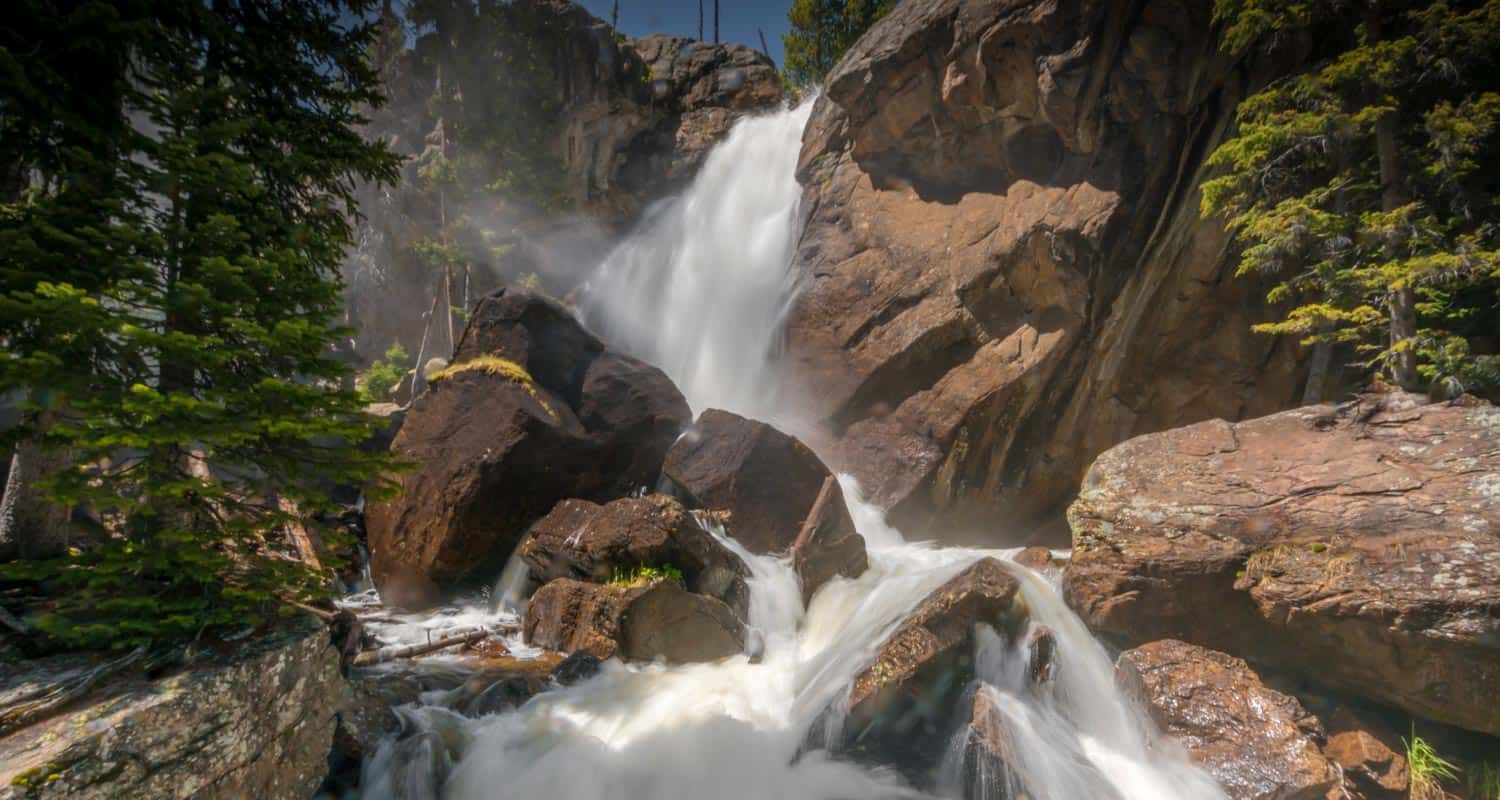
After Ouzel Falls, the trail comes to a junction with the Bluebird Lake trail at 3.1 miles. However, the way to the Lion Lake passes by this junction and keeps going straight/northwest.
In approximately 1.5 mile from the Bluebird Trail junction, the trail makes a final split. The trail to the left leads up to Thunder Lake and Fan Falls. The right leads up to the Lion Lakes and is a hiker-only trail (no horses or pack animals beyond this point). Now you're entering the very heart of Rocky Mountain National Park.
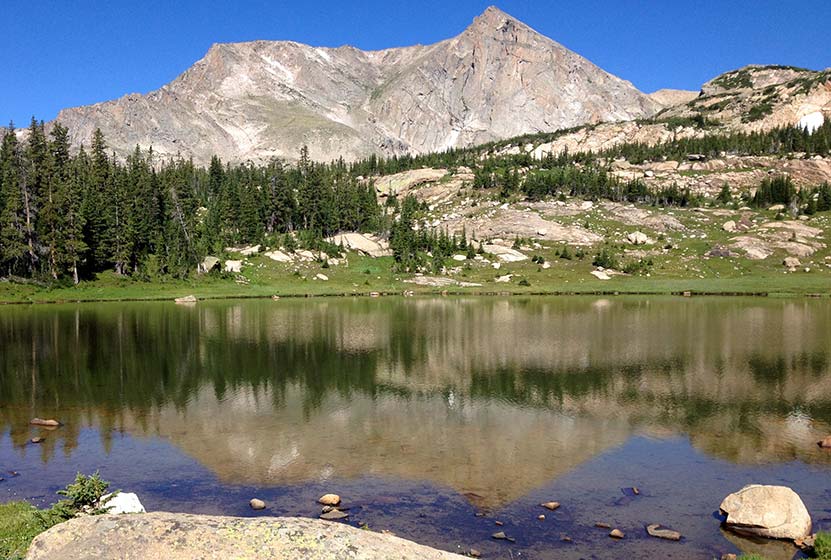
The trail now becomes undulating, with spots of level ground, meadows, boulders, and marsh. It's the kind of diversity that characterizes the beautiful high-country of Colorado. On the approach to Lion Lake #1, Mt. Alice comes into view with it's sheer rock wall and pyramid peak. Moving into the Lion Lakes area, beautiful meadows and marsh hold the delight of wildflowers, and the nuisance of mosquitos.
Following a social trail from the shores of Lion Lake #1, hikers can push on to the Trio Falls and Lion Lake #2. Because this next segment is on unmaintained trails in a remote section of the park, hikers should possess both land navigation skills, map, and equipment.
Tips & Resources for Hiking to Lion Lake #1 in RMNP
- TIP: There are food storage lockers available at the Wild Basin, Finch Lake, and Sandbeach Lake Trailheads. These are required for visitors staying overnight. Make sure there is nothing that smells good to bears left in your car (that includes air fresheners).
- Get there early: Parking may be somewhat limited as with many hikes in RMNP area and can get full even early in the morning.
- Camping: The Thunder Lake campsite and others along this route can be reserved through the Rocky Mountain National Park Wilderness Offices. Because this is an extensive hike in rugged country, it may be wise to make this expedition a part of a multi-day trip.
- You're in Bear Country: Black Bears live in the Wild Basin area and are active on the months of April through November. Be aware, and dispose of your food responsibly.
- Recommended Trail Map for Lion Lake Hike: National Geographic Trails Illustrated Map
- Packing List: Always pack the 10 Essentials. Download our Hiking Guide to get list and dayhiking packing checklist.
- Colorado Road Conditions: Colorado Road Conditions
- Photo: We would like to express our gratitude to Shea Oliver for sharing such amazing photographs of this hike to Lion Lake in RMNP.
- After the Hike: Rock Creek Tavern & Pizzeria
Weather
Map & Driving Directions
Click for Driving Directions
Fan Falls in Rocky Mountain National Park
Fan Falls is tucked away in the high reaches of the Wild Basin of Rocky Mountain National Park. This 15.5 mile, difficult trek, leads to a long set of segmented cascades spilling out of the heights and streaming down into Thunder Lake. This garden of water, wildflowers and rock is a perfect escape for those looking for a demanding hike to a more secluded spot. Explore the entire Fan Falls hike profile below for trail map, driving directions, and more tips and details to help you enjoy this adventure in Rocky Mountain National Park.
Note: Rocky Mountain National Park now requires timed entry permits from May 27th through October 10th. See the RMNP permits page for more information.
Trail Snapshot: Fan Falls in Rocky Mountain National Park
| Hike Distance | 15.5 miles Round Trip |
|---|---|
| Difficulty | Difficult |
| Duration | 8-10+ hr Round Trip |
| Trail Type | Out and Back |
| Starting Elevation | 8566' |
| Elevation Gain | Approx. +2530' |
| Seasons | Late Spring through Early Fall |
| Dogs | Prohibited in RMNP |
| Hike Trail Map | National Geographic Trails Illustrated Map |
| Denver Drive Time | 1 hr 30 min |
| Driving Directions to Wild Basin Trailhead | Click for Google Map |
| Driving Directions to Winter Recreation Parking for Wild Basin Hikes | Click for Google Map |
| Town Nearest Hike | Allenspark, Colorado |
| Beauty | Waterfall, lake, mountain views, meadows, river, wildlife: Abert's squirrel, elk, deer, moose, bear; wildflowers |
| Activities | Picnicking, hiking trails, snowshoeing, horseback riding, backcountry camping (with a permit), photography |
| Fee | Park Pass Required |

A Stream Along the Cascades of Fan Falls
Parking & Trailhead Information for Fan Falls
The southeast corner of Rocky Mountain National Park boasts one of the loveliest portions in the park known as the Wild Basin. The Wild Basin Trailhead is located just 15 minutes outside of Allenspark, Colorado along Highway 115. There is a ranger station at at the Wild Basin Trailhead with toilets and drinking water available.
In the winter (October-May), Hwy 115 may not be plowed to the trailhead, and hikers will need to park their vehicles at a winter parking lot for Wild Basin hikes. Be aware that hikes from the winter parking lot add on another 3 miles of hiking (one-way). There are other small parking areas, like the Finch Lake Trailhead, that may be accessible and allow hikers to park closer to the Wild Basin Trailhead. It's important to know that Hwy 115, though titled a "highway", is a maintained dirt road, which means that it can be used by 2WD vehicles. However, after heavy rains and other severe weather, its quality may degrade until it is repaired. 4WD may be needed when snow is on the ground.
The Hike: Fan Falls Trail in RMNP
The hike up to Fan Falls leads through the central area of the Wild Basin, taking hikers past three sets of cascade waterfalls, around the shore of Thunder Lake, and finally to a lonely creek dropping into a series of rocky cascades.
Beginning at the Wild Basin Trailhead, the trail passes by Copeland Falls, a set of two cascade waterfalls just 0.4 mile into the hike. For details on accessing both the lower and upper leaps of Copeland Falls, be sure to explore our full trail profile for Copeland Falls.
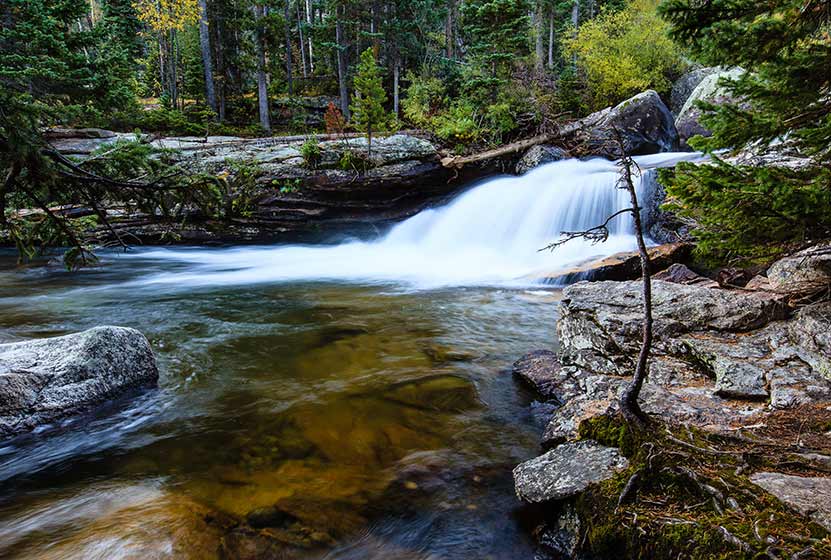
Copeland Falls - Photo Courtesy of Ben Graham
The trail then follows North Saint Vrain Creek, until it meets with a trail junction. The trail to the right leads past a series of backcountry campsites, and is a slightly more direct route to Thunder Lake and Fan Falls. However, the left-hand trail is not much longer and takes hikers past two more waterfalls, Calypso Cascades and Ouzel Falls. The rest of this trail profile will explain this route.
Having taken the left-hand trail, it will soon cross a hefty log bridge spanning North St. Vrain Creek. Stop here to enjoy an unnamed set of cascades. Soon the trail will meet with a second trail junction at Calypso Cascades. The right-hand trail leads hikers to the cascades, over another bridge that crosses Cony Creek at 1.8 miles, then weaves up a set of switchbacks to Ouzel Falls at 2.7 miles.

Calypso Cascades - Photo Courtesy of Jeff Kramer
After Ouzel Falls, the trail comes to a junction with the Bluebird Lake trail at 3.7 miles. However, the way to Fan falls passes by this junction and keeps going straight/northwest. In approximately 1.5 mile from the Bluebird Trail junction, the trail makes a final split. The right leads up to the Lion Lakes and to Thunder Falls. The trail to the left leads up to Thunder Lake and Fan Falls.
At Thunder Lake, the way to Fan Falls requires some listening and attention to the landscape. Hikers should be familiar with backcountry travel and land navigation because this remaining segment requires hiking on unmarked and lesser traveled social trails. Hiking along the right/north side of the lake, the way leads into the forest. When the trees open up into a clearing, the sounds of Fan Falls become apparent. Following the sound of the waterfall and the creek, hikers can pick their way through rock, brush, and deadfall until reaching the base of Fan Falls. Bluebells and other wildflowers grow out from between the rock, painting the splash and spray of the cascades with color.
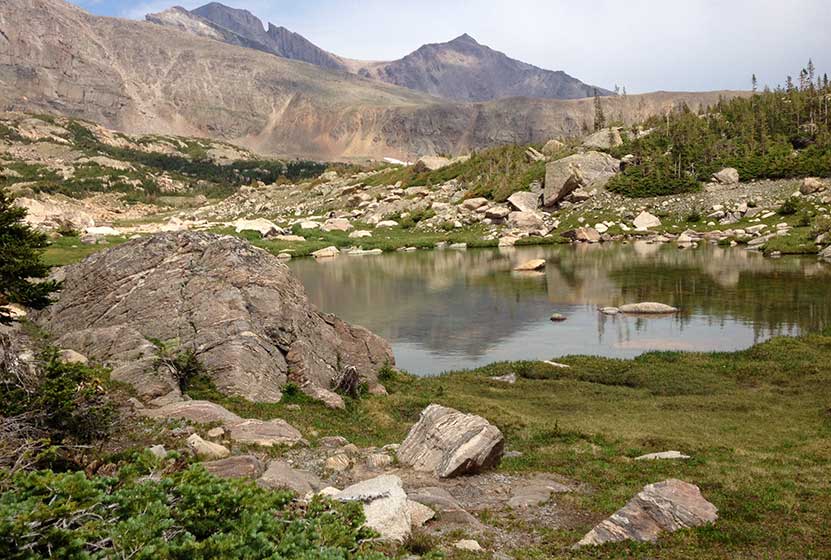
A Pond Above Fan Falls in RMNP
The source of Fan Falls can be accessed by hiking higher to the area above the cascades. Here, a small pond holding the meltwater from the winter's snow reflects the towering and craggy peaks that surround it.
The return hike traces the same route. However, one change can be made: Instead of taking the trail back to Ouzel Falls and Calypso Cascades, hikers can take the trail that stays to the North/left of North St. Vrain creek and passes the several backcountry campsites.
Tips & Resources for Hiking to Fan Falls in RMNP
- Camping: The Thunder Lake campsite and others along this route can be reserved through the Rocky Mountain National Park Wilderness Offices. Because this is an extensive hike in rugged country, it may be wise to make this expedition a part of a multi-day trip.
- Lockers: There are food storage lockers available at the Wild Basin, Finch Lake, and Sandbeach Lake Trailheads. These are required for visitors staying overnight.
- Get there early: Parking may be somewhat limited as with many hikes in RMNP area and can get full even early in the morning.
- You're in Bear Country: Black Bears live in the Wild Basin area and are active on the months of April through November. Be aware, and dispose of your food responsibly.
- Recommended Map for Rocky Mountain National Park: The trail maps provided by Rocky Mountain National Park are usually sufficient. However, for the hike up to Fan Falls, we highly recommend purchasing a National Geographic Trails Illustrated Map.
- Packing List: Always pack the 10 Essentials. Download our Hiking Guide to get list and dayhiking packing checklist.
- Colorado Road Conditions: Colorado Road Conditions
- Photo: We would like to express our gratitude to Shea Oliver for sharing such amazing photographs of this hike to Fan Falls in RMNP.
- After the Hike: Meadow Mountain Cafe in Allenspark, CO
Weather
Map & Driving Directions
Click for Driving Directions
Calypso Cascades in Rocky Mountain National Park
Calypso Cascades is an easy 3.6 mile hike to one of several waterfall destinations along this section of trail. This waterfall in the Wild Basin of Rocky Mountain National Park is gets its name from the purple Calypso Orchids that bloom along the banks of Cony Creek. Explore the full Calypso Cascades hike profile below for trail map, driving directions, and more tips and details to help you enjoy this adventure in Rocky Mountain National Park.
Note: Rocky Mountain National Park now requires timed entry permits from May 27th through October 10th. See the RMNP permits page for more information.
Trail Snapshot: Calypso Cascades in Rocky Mountain National Park
| Hike Distance | 3.6 miles Round Trip |
|---|---|
| Difficulty | Easy |
| Duration | 2-3 hr Round Trip |
| Trail Type | Out and Back |
| Starting Elevation | 8566' |
| Elevation Gain | Approx. +700' |
| Seasons | Spring through Fall, Winter Snowshoeing |
| Dogs | Prohibited in RMNP |
| Hike Trail Map | Click for a Map of Calypso Cascades RMNP |
| Denver Drive Time | 1 hr 30 min |
| Driving Directions to Wild Basin Trailhead | Click for Google Map |
| Driving Directions to Winter Recreation Parking for Wild Basin Hikes | Click for Google Map |
| Town Nearest Hike | Allenspark, Colorado |
| Beauty | Waterfall, mountain views, meadows, river, wildlife: Abert's squirrel, elk, deer, moose, bear; wildflowers |
| Activities | Picnicking, hiking trails, snowshoeing, horseback riding, backcountry camping (with a permit), photography |
| Fee | Park Pass Required |
Parking & Trailhead Information for Calypso Cascades
The southeast corner of Rocky Mountain National Park boasts one of the loveliest portions in the park known as the Wild Basin. The Wild Basin Trailhead is located just 15 minutes outside of Allenspark, Colorado along Highway 115. There is a ranger station at at the Wild Basin Trailhead with toilets and drinking water available.
In the winter (October-May), Hwy 115 may not be plowed to the trailhead, and hikers will need to park their vehicles at a winter parking lot for Wild Basin hikes. Be aware that hikes from the winter parking lot add on another 3 miles of hiking (one-way). There are other small parking areas, like the Finch Lake Trailhead, that may be accessible and allow hikers to park closer to the Wild Basin Trailhead. It's important to know that Hwy 115, though titled a "highway", is a maintained dirt road, which means that it can be used by 2WD vehicles. However, after heavy rains and other severe weather, its quality may degrade until it is repaired. 4WD may be needed when snow is on the ground.

Calypso Cascades From Below
The Hike: Calypso Cascades Trail in RMNP
The hike to Calypso Cascades begins at the Wild Basin Trailhead, and at just .3 mile into the trail, passes by both the lower and upper leaps of Copeland Falls. Read our full trail profile on Copeland Falls for details on how to access both sets of cascades.
After taking in the views at Copeland Falls, the trail follows the course of North St. Vrain Creek as it flows out of the rugged high country and snowfields in this wild corner of Rocky Mountain National Park. Soon the trail will split. The right-hand trail leads through a segment of trail with 5 different backcountry camping sites and on towards Thunder and Lion lakes. These backcountry camping sites can be reserved through the RMNP Backcountry Offices. The left-hand trail leads south towards Calypso Cascades and Finch Lake Trail system.
Taking the Finch Lake Trail, hikers will cross a large log bridge spanning North St. Vrain Creek. Near the bridge, you'll discover an unnamed set of cascades. After crossing the bridge, the trail follows Cony Creek for about 0.4 mile to the site of Calypso Cascades. Calypso Cascades are reminiscent of Fern Falls: the waters of Cony Creek tumble over boulders and fallen trees in a moss-covered landscape. What makes Calypso Cascades unique are the Calypso Orchids (also known as Pink Lady Slippers) that bloom in the late-spring and early-summer along the creek.
Hikers can return to the trailhead to make this a 3.6 mile hike, or can continue on the Finch Lake trail for approximately 1 mile to the site of Ouzel Falls.
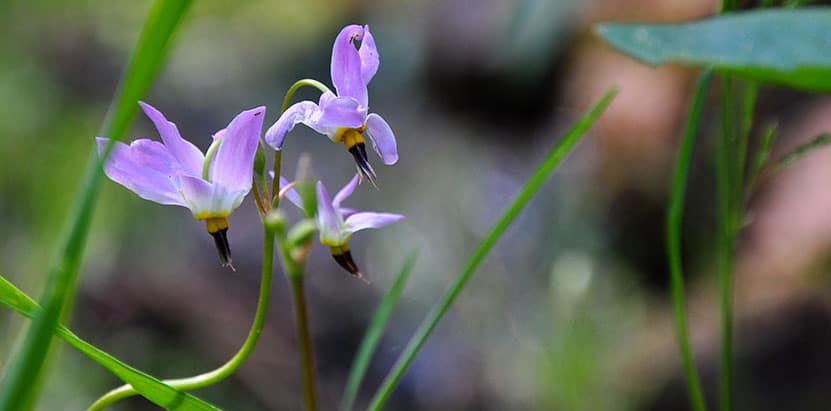
Pink Fairy Slipper Flower
Tips & Resources for Hiking to Calypso Cascades in RMNP
- TIP: The area near the bridge over North St. Vrain Creek can be a great spot for a picnic.
- Packing List: Always pack the 10 Essentials. Download our Hiking Guide to get list and dayhiking packing checklist.
- TIP: There are food storage lockers available at the Wild Basin, Finch Lake, and Sandbeach Lake Trailheads. These are required for visitors staying overnight.
- Get there early: Parking lot might get full even early in the morning.
- You're in Bear Country: Black Bears live in the Wild Basin area and are active on the months of April through November. Be aware, dispose of your food responsibly, and don't food or anything else with a strong scent in your vehicle.
- Trail Map for Wild Basin Area: Trail Map Link
- Colorado Road Conditions: Colorado Road Conditions
- Photo: We would like to express our gratitude to Jeff Kramer for sharing such an amazing photograph of this hike to Calypso Cascades in RMNP.
- After the Hike: Meadow Mountain Cafe
Weather
Map & Driving Directions
Click for Driving Directions
Ouzel Falls in Rocky Mountain National Park
Ouzel Falls spills over a cliffside and enormous boulders, making it arguably one of the most beautiful waterfalls in Rocky Mountain National Park. Before reaching this 40-foot falls, the trail traces the course of several creeks and leads hikers past three other cascade waterfalls. Explore the full Ouzel Falls hike profile below for trail map, driving directions, and more tips and details to help you enjoy this adventure in the Wild Basin of Rocky Mountain National Park.
Note: Rocky Mountain National Park now requires timed entry permits from May 27th through October 10th. See the RMNP permits page for more information.
Trail Snapshot: Ouzel Falls in Rocky Mountain National Park
| Hike Distance | 5.4 miles Round Trip |
|---|---|
| Difficulty | Moderate |
| Duration | 3 - 4 hr Round Trip |
| Trail Type | Out and Back |
| Starting Elevation | 8566' |
| Elevation Gain | Approx +950' |
| Seasons | Spring through Fall, Winter Snowshoeing |
| Dogs | Prohibited in RMNP |
| Hike Trail Map | Click for a Map of Ouzel Falls RMNP |
| Denver Drive Time | 1 hr 30 min |
| Driving Directions to Wild Basin Trailhead | Click for Google Map |
| Driving Directions to Winter Recreation Parking for Wild Basin Hikes | Click for Google Map |
| Town Nearest Hike | Allenspark, Colorado |
| Beauty | Waterfall, mountain views, meadows, river, wildlife: Abert's squirrel, elk, deer, moose, bear; wildflowers |
| Activities | Picnicking, hiking trails, snowshoeing, horseback riding, backcountry camping (with a permit), photography |
| Fee | Park Pass Required |
Parking & Trailhead Information for Ouzel Falls
The southeast corner of Rocky Mountain National Park boasts one of the loveliest portions in the park known as the Wild Basin. The Wild Basin Trailhead is located just 15 minutes outside of Allenspark, Colorado along Highway 115. There is a ranger station at at the Wild Basin Trailhead with toilets and drinking water available.
In the winter (October-May), Hwy 115 may not be plowed to the trailhead, and hikers will need to park their vehicles at a winter parking lot for Wild Basin hikes. Be aware that hikes from the winter parking lot add on another 3 miles of hiking (one-way). There are other small parking areas, like the Finch Lake Trailhead, that may be accessible and allow hikers to park closer to the Wild Basin Trailhead. It's important to know that Hwy 115, though titled a "highway", is a maintained dirt road, which means that it can be used by 2WD vehicles. However, after heavy rains and other severe weather, its quality may degrade until it is repaired. 4WD may be needed when snow is on the ground.
The Hike: Ouzel Falls Trail in RMNP
This 2.7 mile hike (one-way) begins at the Wild Basin Trailhead and passes three other cascade waterfalls before arriving at the Ouzel Falls. Copeland Falls are found just 0.4 miles into the hike. For details on locating both the lower and upper cascades, explore our full trail profile on Copeland Falls. After Copeland Falls, the trail continues following alongside North Saint Vrain Creek for about 1 mile to where it splits. The right-hand trail leads south to a log bridge crossing the creek. Near the bridge, hikers can take in the sights and sounds of another small cascade.
The trail continues south to Calypso Cascades, the third and final cascade waterfall before reaching Ouzel Falls. Here the trail splits again. The left-hand/east trail leads aback towards the Finch Lake trail and the Allenspark Trailhead. The right-hand/west trail leads towards Ouzel Falls and the Bluebird Lake Trail. Here, the trail crosses a set of two bridges, then climbs uphill through a set of switchbacks. The mountains to the north now come into view, both Mt. Meeker, Pagoda, and Longs Peak. This segment of trail between Calypso Cascades and Ouzel Falls is approximately 1 mile.
A second set of switchbacks brings hikers within earshot of the falls, and they will come into view at the bridge that crosses over Ouzel Creek. However, the best views of the falls can be gained via a social trail that is located before the bridge on the left side of the creek. This unmaintained trail leads to an area above the falls with incredible views of alpine meadows and craggy peaks. As with any social trails, please use the most worn paths and hike on durable surfaces. Be aware that the rock can become slick in this area and hikers should exercise caution when navigating above the falls.
Ouzel Falls is named after the Ouzel or Water-Dipper, the only songbird that lives a mostly aquatic life. Ouzels weave globe-shaped nests near waterfalls, lakes, and streams. They dive--even walk--underwater to catch insects and larvae.
Hikers can return the 2.7 miles back they way they came to Ouzel Falls, or can hike further to destinations such as Ouzel Lake (an additional 2.2 miles, one-way).

Ouzel Falls on a Wet Spring Day - Courtesy of Chris Heald
Tips & Resources for Hiking to Ouzel Falls in RMNP
- Get there early: Parking may be somewhat limited as with many hikes in RMNP. Parking at the trailhead can fill up, even in the early morning.
- You're in Bear Country: Black Bears live in the Wild Basin area and are active on the months of April through November. Be aware, and dispose of your food responsibly. Be sure that no food or strong scented items are left in your car.
- TIP: There are food storage lockers available at the Wild Basin, Finch Lake, and Sandbeach Lake Trailheads. These are required for visitors staying overnight.
- Trail Map for Wild Basin Area: Trail Map Link
- Packing List: Always pack the 10 Essentials. Download our Hiking Guide to get list and dayhiking packing checklist.
- Colorado Road Conditions: Colorado Road Conditions
- Photo: We would like to express our gratitude to Steven Bratman for sharing such an amazing photograph of this hike to Ouzel Falls in RMNP.
- After the Hike: Meadow Mountain Cafe
Weather
Map & Driving Directions
Click for Driving Directions
Cub Lake Loop in Rocky Mountain National Park
The Cub Lake Loop Hike in Rocky Mountain National Park is a great alternative to the an out-and-back hike up to Cub Lake. Along the way, hikers will pass by Windy Gulch Cascades, travel alongside the Big Thompson River, cross over an area called The Pool, journey through wetlands, and will be surrounded by sights of a glacial-shaped landscape. Explore the full hike profile below for trail map, driving directions, and all the details you need to enjoy this adventure in Rocky Mountain National Park.
Note: Rocky Mountain National Park now requires timed entry permits from May 27th through October 10th. See the RMNP permits page for more information.
Trail Snapshot: Cub Lake Loop in Rocky Mountain National Park
| Hike Distance | 6 miles |
|---|---|
| Difficulty | Moderate |
| Duration | Approx 2-4 hrs |
| Trail Type | Loop |
| Starting Elevation | 8080' |
| Elevation Gain | Approx. +540' |
| Seasons | Spring through Fall, Winter Snowshoeing |
| Dogs | Prohibited in RMNP |
| Hike Trail Map | Click for a Map of Cub Lake Loop RMNP |
| Denver Drive Time | 1 hr 40 min |
| Driving Directions to Cub Lake Trailhead | Click for Google Map |
| Driving Directions to Fern Lake Trailhead | Click for Google Map |
| Driving Directions to Park & Ride Trailhead | Click for Google Map |
| Town Nearest Hike | Estes Park, Colorado |
| Beauty | Sub-alpine lakes, mountain views, meadows, river, wildlife: Abert's squirrel, elk, deer, moose, duck, bear; yellow pond lilies and wildflowers |
| Activities | Picnicking, hiking trails, snowshoeing, horseback riding, backcountry camping (with a permit) |
| Fee | Park Pass Required |
Cub Lake Loop Hike Waypoints
A: 0.0 miles : Cub Lake Trailhead
B: 0.2 miles : Parking Lot
C: 0.8 miles : Fern Lake Trailhead
D: 2.5 miles : The Pool
E: 3.5 miles : Cub Lake Trail - Hollowell Park Trail Intersection
F: 3.7 miles : Cub Lake
G: 5.7 miles : Cub Lake Trail - South Lateral Moraine Trail Intersection
H: 6.0 miles : Cub Lake Trailhead
Parking & Trailhead Information for Cub Lake Loop
The Cub Lake Trailhead in Rocky Mountain National Park has a very small parking area where only 7 to 8 vehicles can park. Chances are, if you don't arrive early in the morning, you'll need to park just .3 mile further down the road at the Fern Lake Bus Stop parking area. If both lots are full, then your best bet is to park in the RMNP Park & Ride lot and use the shuttle service to get to the Cub Lake Trailhead. Please do not park alongside the road. This causes significant erosion and damage to roadside--and you might get a ticket.
The Hike to Cub Lake Loop in RMNP
This hike profile for the Cub Lake Loop in RMNP is hiked counter-clockwise from the Cub Lake parking area. However, it can be hiked the other direction--it's all a matter of preference. The hike can also be started at the Fern Lake Trailhead.
Beginning at the Trailhead, the first mile follows the dirt road past the Fern Lake bus stop, then through a grove of aspens to the Fern Lake trailhead. The first sight along the trail worth stopping to see are the Windy Gulch Cascades. They are about .4 mile into the Fern Lake Trail, tucked away in a gulch high above the valley. You'll hear them first, but a footbridge and water across the trail will key hikers into the location of the cascades. We've created a full hike profile on Windy Gulch Cascades, if you would like more detailed information on this hidden waterfall in Rocky Mountain National Park.
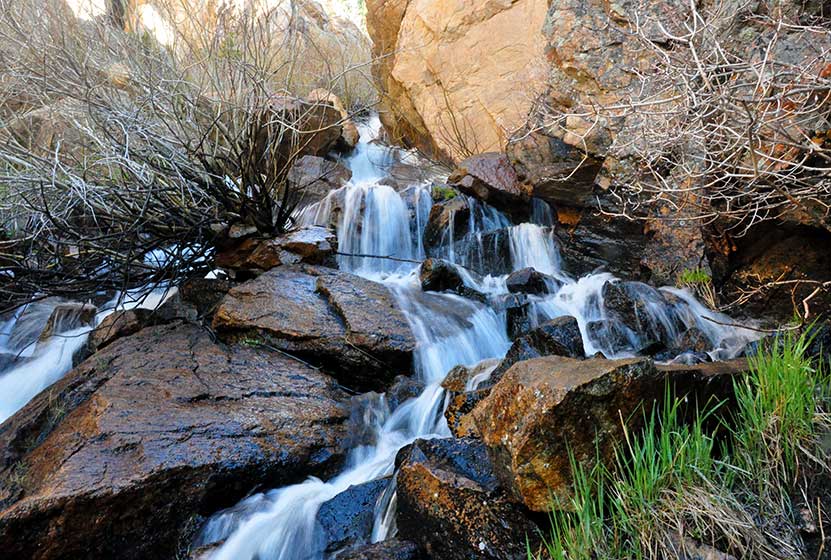
The next sight along the trail is Arch Rocks, where the trail winds through a series of boulders, including two massive rocks that fell from the cliffs above into the valley many eons ago. Shortly after Arch Rocks, the sounds of the Big Thompson River, Spruce Creek, and Fern Creek will fill the air. At the confluence of these streams, a bridge crosses the area named "The Pool."
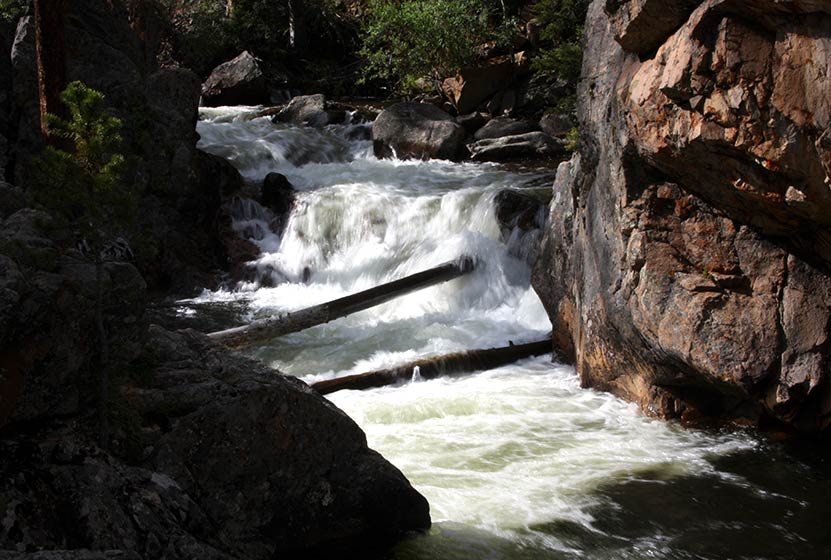
The Pool - Courtesy of Steve Wallace
After crossing the bridge at The Pool, the trail splits. The right-hand trail makes its way up to Fern Falls and Fern Lake. The left-hand trail leads to the lake--this left-hand trail is the correct trail for completing the loop. The trail then bends south, then turns east and climbs up the South Lateral Moraine. This 1.2 mile segment from the Pool to Cub Lake is the most demanding part of the hike. The trail encounters a second trail junction with the Hollowell Park Trail which bears to the right. The trail to Hollowell Park is a beautiful detour, but leads away from Cub Lake. To stay on the Cub Lake loop, hikers will continue east on the Cub Lake Trail.

A Sea of Lily Pads on Cub Lake - Courtesy of Steve Harbula
Soon after the junction, the trail descends to Cub Lake. Some of the best views of the Lake come from this segment of trail. The trail then runs along the shore of the Lake before it makes a steep descent through a strange and wild area scraped by an ancient glacier and riddled with boulders.
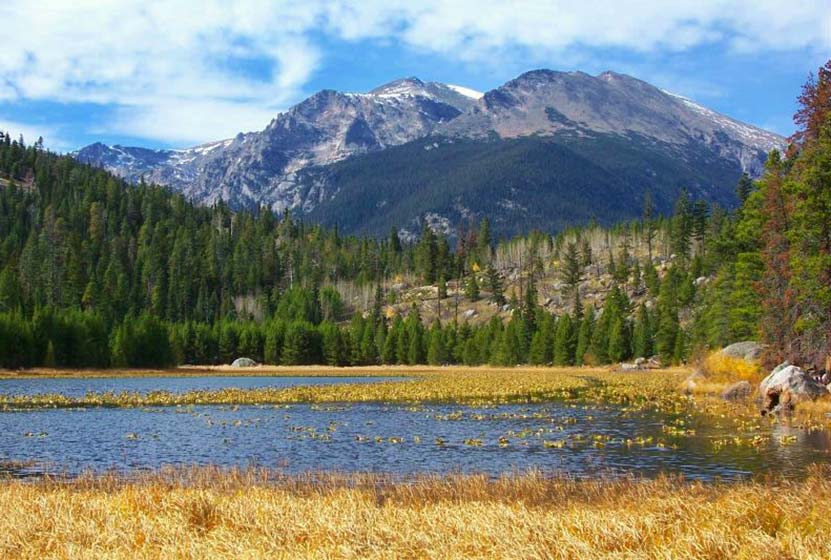
Cub Lake in RMNP - Courtesy of Barbara Morgan
The final trail segment leads through forest and marshland, across bridges, and down into the western edges of Moraine Park. Here, hikers will likely see elk grazing, and hear and see an extensive variety of birds among the shrubs and aspens. Before crossing into Moraine Park, the trail will split again. The right-hand trail leading along the South Lateral Moraine. The trail back to the Cub Lake and Fern Lake Trailheads, continues North/Left for about 1/3 of a mile back to the Cub Lake Trailhead.
Tips & Resources for Hiking to Cub Lake Loop in RMNP
- TIP: It is advisable to arrive early as parking is limited. One may opt to ride a shuttle that drops you off at the trailhead.
- TIP: Take advantage of the free park shuttle to get to the trailhead during peak seasons.
- Bring A Picnic Lunch: The banks along the Big Thompson River can be a great place for picnics.
- Bug Spray: Because of the amount of water along this hike, hikers will likely encounter a fair share of mosquitos; so, bring some bug spray.
- Trail Map for Bear Lake Corridor: Trail Map Link
- Packing List: Always pack the 10 Essentials. Download our Hiking Guide to get list and dayhiking packing checklist.
- Colorado Road Conditions: Colorado Road Conditions
- Photo: We would like to express our gratitude to Andrew Mace for sharing such an amazing photograph of this hike in RMNP.
- After the Hike: Mountain Home Café
Weather
Map & Driving Directions
Click for Driving Directions


